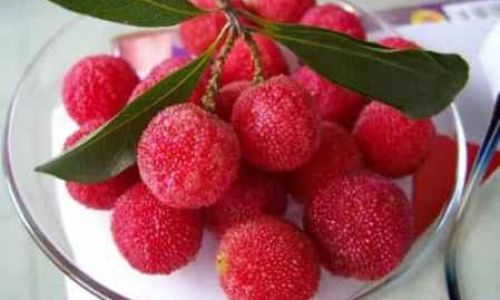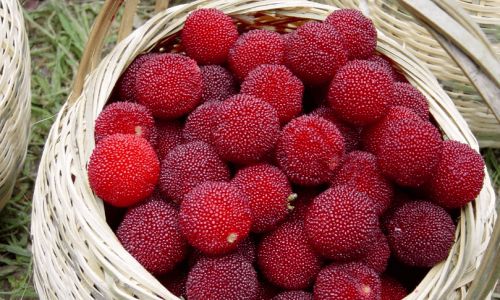Introduction
The red bayberry, known scientifically as Myrica rubra, is a fruit cherished for its unique sweetness, tartness, and vibrant color. Native to East Asia, particularly China, this seasonal delicacy is highly valued not only for its taste but also for its nutritional benefits, which include antioxidants, vitamins, and minerals. However, the fleeting nature of its freshness poses a challenge for both farmers and consumers alike. Ensuring that red bayberries retain their vibrant hue, juicy texture, and delicious flavor from harvest to consumption requires meticulous handling and storage techniques. This article delves into the intricacies of harvesting red bayberries and preserving their freshness, offering practical advice for both small-scale growers and commercial producers.
Harvesting Techniques
The first step in preserving the freshness of red bayberries begins with careful harvesting practices. Timing is crucial, as the optimal harvest window is narrow and depends on various environmental factors such as climate, soil conditions, and variety.
Identifying the Right Stage of Ripeness

Red bayberries ripen unevenly on the tree, with some fruits maturing earlier than others. It’s essential to harvest only fully ripe berries, characterized by their deep red color, firmness, and a slight give when gently pressed. Overripe berries, which are often softer and more prone to bruising, should be avoided as they won’t store well.
Harvesting Methods
Hand-picking is the preferred method for harvesting red bayberries. This ensures that only ripe fruits are selected while minimizing damage to the tree and surrounding berries. Gloves should be worn to protect the hands from the fruit’s natural oils, which can cause skin irritation. A gentle twist or snap motion is used to detach the berries from the stem, preserving the integrity of the fruit and reducing the risk of bruising.
Weather Considerations
Harvesting should ideally take place during dry weather to prevent moisture-related issues such as mold and rot. If rain is forecasted, it’s advisable to postpone the harvest until conditions improve. Additionally, early morning or late afternoon harvests are preferable as temperatures are cooler, reducing the risk of heat-related spoilage.
Post-Harvest Handling
Once harvested, immediate and proper handling is vital to extend the shelf life of red bayberries.
Sorting and Grading
Immediately after harvesting, berries should be sorted to remove any damaged, overripe, or underripe fruits. Sorting also involves grading the berries based on size and quality, which is essential for marketing and ensuring consistent storage conditions.
Cooling
Prompt cooling is crucial to slow down the ripening process and prevent spoilage. Red bayberries should be cooled to a temperature of around 3-5°C (37.4-41°F) as soon as possible after harvesting. This can be achieved using refrigerated trucks or on-farm cooling facilities. If immediate cooling isn’t possible, placing the berries in shaded, ventilated areas can provide a temporary solution.
Packaging

Proper packaging is another key factor in preserving the freshness of red bayberries. Ventilated containers or perforated plastic bags are ideal, allowing for adequate airflow while protecting the berries from physical damage. Avoid using airtight containers, as this can lead to moisture build-up and increased risk of mold.
Storage Techniques
Maintaining optimal storage conditions is paramount to retaining the quality of red bayberries over an extended period.
Refrigerated Storage
Refrigeration is the most effective way to extend the shelf life of red bayberries. Stored at 0-2°C (32-35.6°F) with high humidity (around 90-95%), berries can last up to two weeks. It’s important to monitor the temperature and humidity levels regularly to ensure they remain within the optimal range.
Controlled Atmosphere Storage
For longer-term storage, controlled atmosphere (CA) storage can be employed. This involves adjusting the oxygen and carbon dioxide levels in the storage environment to slow down respiration and metabolic processes, further extending the shelf life. Typically, an oxygen level of 1-3% and a carbon dioxide level of 2-5% is used. However, this method requires specialized equipment and careful monitoring to avoid oxygen deficiency or carbon dioxide toxicity.
Modified Atmosphere Packaging (MAP)
Modified atmosphere packaging is another advanced technique that can be used in conjunction with refrigerated storage. MAP involves sealing the berries in packages with a specific gas mixture (similar to CA storage conditions) to create an optimal microenvironment. This not only extends shelf life but also enhances the visual appeal and flavor of the berries.
Freezing
For long-term preservation, freezing is an option. Red bayberries can be frozen either whole or as puree. To maintain quality, berries should be washed, dried, and then quickly frozen at -30°C (-22°F) or below. Once frozen, they can be transferred to freezer bags or containers and stored at -18°C (0°F) for up to a year. While freezing preserves the berries’ nutritional value, it alters their texture, making them suitable for cooking or blending rather than fresh consumption.
Consumer Tips for Maintaining Freshness

For consumers, maintaining the freshness of red bayberries purchased from markets or farms involves similar principles.
Prompt Refrigeration
As soon as you get home, transfer the berries to the refrigerator’s crisper drawer, where humidity is higher. Avoid placing them in the door compartment, as temperature fluctuations can affect their quality.
Proper Handling
When handling red bayberries, wash them only when you’re ready to eat them, as moisture can accelerate spoilage. Use a gentle rinse with cold water and dry them thoroughly with a paper towel.
Consumption Priority
Eat the berries that are ripest first, as they will spoil the quickest. Inspect the berries regularly, removing any that show signs of mold or decay to prevent the spread to other fruits.
Conclusion
Preserving the freshness of red bayberries from harvest to consumption is a multi-faceted process that requires careful planning and execution. By adopting proper harvesting techniques, prompt post-harvest handling, and optimal storage conditions, both farmers and consumers can enjoy the delightful taste and nutritional benefits of this seasonal treasure for longer periods. As research continues to uncover new methods for preserving perishable fruits, the potential for extending the shelf life of red bayberries and other delicate produce will undoubtedly grow, making these natural delicacies accessible to more people around the world.






0 comments